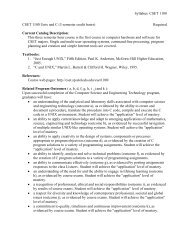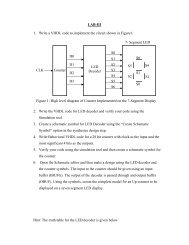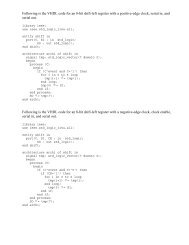Programmable Logic and Application Specific Integrated Circuits
Programmable Logic and Application Specific Integrated Circuits
Programmable Logic and Application Specific Integrated Circuits
Create successful ePaper yourself
Turn your PDF publications into a flip-book with our unique Google optimized e-Paper software.
technologies. These techniques are identical to those described for PALs <strong>and</strong> PLDs in the<br />
previous section, <strong>and</strong> will not be discussed further here.<br />
An alternative method to personalize FPGA devices is to physically program the routing<br />
connections. Commercial products which use programmable routing approaches have been<br />
introduced by Actel, Quick<strong>Logic</strong>, <strong>and</strong> others. In Actel FPGAs, a <strong>Programmable</strong> Low-Impedance<br />
Circuit Element (PLICE) anti-fuse element is used. 12 The anti-fuse resistance which is normally<br />
very high (>100MΩ) is permanently changed to a low resistance (200-500Ω) by the application of<br />
appropriate programming voltages. The programmed anti-fuse is used to make a direct electrical<br />
connection between two metal lines as shown in the layout view of Figure 9. The PLICE anti-fuse<br />
is manufactured by adding three specialized masks to a st<strong>and</strong>ard CMOS process. The physical<br />
structure, identified at the center of Figure 9, consists of an Oxide-Nitride-Oxide dielectric layer<br />
s<strong>and</strong>wiched between a top polysilicon layer <strong>and</strong> a bottom N+ diffusion layer. Programming is<br />
accomplished by applying a relatively high voltage (18V) across the device <strong>and</strong> driving a high<br />
current through the link dielectric. This causes the dielectric to melt <strong>and</strong> results in a conductive<br />
link between the top <strong>and</strong> bottom terminals.<br />
Quick<strong>Logic</strong> also adds a unique three layer structure to the st<strong>and</strong>ard CMOS process to<br />
create their anti-fuse element; which they call a ViaLink. 13 The ViaLink uses an amorphous<br />
silicon layer which is s<strong>and</strong>wiched between the first <strong>and</strong> second metal layers. An unprogrammed<br />
ViaLink has greater than 1GΩ resistance <strong>and</strong>, like the PLICE anti-fuse, is programmed by applying<br />
a higher than normal voltage. The resulting high current through the amorphous layer causes it to<br />
permanently change to a conductive state with a typical resistance of only 80Ω. The area occupied<br />
by these anti-fuse elements is very small when compared to the other programming alternatives.<br />
While this contributes to improved on-chip gate density, it is somewhat offset by the large area<br />
required for the high-voltage transistors needed to support programming. An additional<br />
disadvantage of the anti-fuse technologies is that they require modifications to the st<strong>and</strong>ard CMOS<br />
process.<br />
18
















